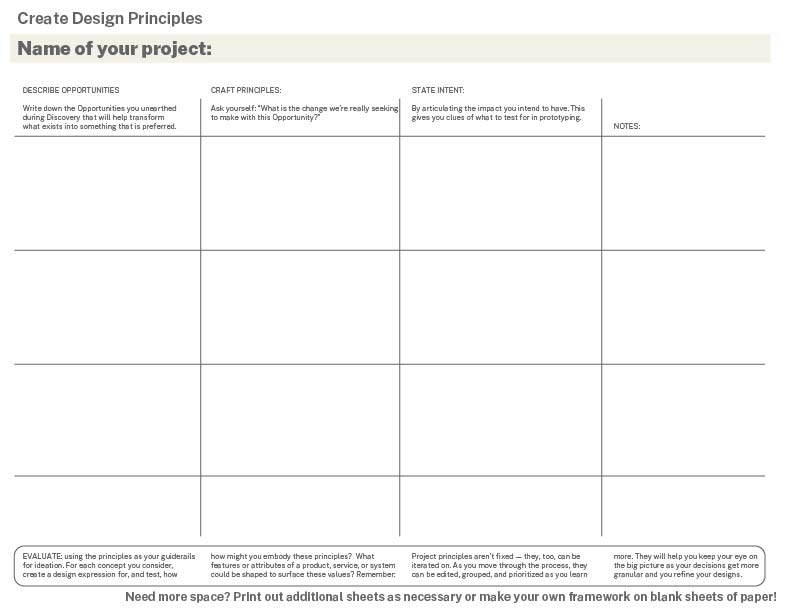Design Operations Guide
Create Principles
Working as a Team to Create Principles
To set expectations on what you’ll accomplish together, design teams create project-level principles at the outset of the Design phase. These principles are valuable tools throughout a project’s development, framing the design work so that it stays inside the boundaries of research.
Project-level principles reflect an organization’s strategy and mission, which is perhaps articulated through a set of global design principles, but in a focused and outcome-oriented way. Project-level principles answer why the team is undertaking a design phase; they define the space of work in the same way the Problem Framing work defined the problem frame for discovery. , aligning everyone to a shared project direction. They’re not tactical goals, but are instead a continual reference for the team to guide design direction while hewing to your research.
In evaluating a project’s success, these principles can be used to track how the project outcomes map to its original intentions. While the majority of design phases attempt to adhere to the design principles articulated at their outsets, this is not always the outcome. Similar to the Discovery phase, if participant feedback indicates that the team’s direction does not serve participant needs, the Design phase, including principles, must be refocused and restarted.
In this guide, we will articulate project-level principles to aid teams in their upcoming design phase. Global design principles are typically used in large-scale complex initiatives. Because they are communicated to wide range of stakeholders to guide collaborations across multiple projects, global design principles can take months, and sometimes even years, of skilled design facilitation to develop.
- For a set of design principles applicable to design projects in general, please see the Global Design Principles section in the HCD Design Phase Concept Guide.
Why Create Principles?
We can use the principles created for the HCD Guide Series as an example of this part of the set up work. These principles include:
Audience: Our audience are mid-level management to senior leaders leading generative (not reductive or evaluative) projects and who have some support from professional designers.
Logic: Maintaining consistently scaled logic across the Guide Series is paramount. No glib exhortations to “Practice empathy!” in one line and in the next line reminding the reader to bring Sharpies. We will unpack complicated terms like empathy through plain language and engaging graphics.
Visual Communication: If we had time to make these Guides graphic novels, we would. Every place we could possibly show instead of tell, we would do that work.
These principles, among others, help us stay inside a defined space as we create these Guides. Without writing down boundaries for your project in the form of design principles, it’s easy to get lost in the flow of a project. Principles keep you focused on creating solutions that are both most important to your participants and that are inside the opportunity spaces you identified back in your Discovery phase.
Framework: How to Create Project-Level Principles
To create design principles, step back from the tactical demands of your project. This activity is high-level thinking, not tactical. These principles should define the kind of preferred outcome you drive towards in the design phase, rather than the details of what you shape to get there. Steps to creating and using project level principles:
- Reflect on your key insights (the ones that you have determined must be addressed in any design solution).
- Craft principles that articulate the values you bring to your innovation practice as you shape a preferred condition. (A helpful prompt is to ask yourself what do these opportunities tell us about a new approach that might be taken? What kind of experience is most important to the people who will be interacting with this design? What ideas would be embodied in an ideal scenario?)
- State the intent of these principles. What do you imagine will happen if they are applied? This helps ground your design concepts with intention so that iterations of your idea can be tested in relation to your intent.
- As you move through the ideation phase (coming next!) and your iteration phases (two steps away!), evaluate your concepts in terms of how much they embody the principles.
- There’s an important distinction here between improving a system or process and a generative design phase. If you find yourself in a position where the system seems to be fine, but just needs slight changes, we recommend that you exit from this Guide and seek out Systems Redesign guidance.
- If the design opportunities you have found require substantial change to a current product, service, or system, or the creation of a new product, service, or system to complement or build out existing ones, then continue your design process by creating these principles to define your intended impact. Keep these principles front-of-mind to evaluate whether you have made a principled change in the existing experience as you step through the design phase.
- Use the framework to create Design Principles for your project. Use the example principles as models for your work.
